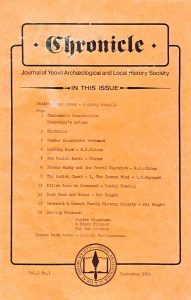1978-Sep-pg9-10_The Parish Chest – 1, The Common Mind
This article came from the Chronicle published September 1978. Pages 9-10
THE PARISH CHEST –
1, THE COMMON MIND
Author: L.C.Hayward
Andrew Everton, who was churchwarden of St John’s Church, Yeovil, from 1729 to 1731 and again in 1757, made a transcript of thirty-three 16th century churchwardens’ account rolls which were presented to the church some few years ago. The late Mr John Goodchild discovered thirteen, original Account Rolls, beautifully inscribed on parchment, dating from this period, some of which are very well preserved, and these together with six 17th century rolls are now in the Somerset Record Office.
A comparison of Everton’s transcripts with the originals in the ten cases where this is possible, proves the care and accuracy with which they were copied, so that now we have twenty-three additional Account Rolls for the Tudor period, the earliest dated 1516 and the latest 1587. In addition Dr J.H.Bettey, Staff Tutor in Local History in the Extra-Mural Department of Bristol University, has drawn attention to a complete transcript of Yeovil Churchwardens’ Accounts for the year 1457-8 published in the original Latin by J.Nichols in Collectanea (1836) from material ‘communicated by Mr.J. Batten, Jnr’ of Yeovil. Since the Parish Chest contains three bound volumes of Churchwardens’ Accounts covering the years 1693 to 1857, the student can use sources covering four centuries in reconstructing the life of the parish.
The century before the Reformation saw manifestations of medieval piety on a growing scale; pilgrimages like that to the supposed shrine of St Joseph of Arimathea at Glastonbury, the cult of the Blessed Virgin Mary in whose name a chantry was dedicated in St.John’s Church, and the foundation of chantries for saying masses for the dead, like that of the Holy Cross (1433) and the Name of Jesus (1480) in St John’s. The account for 1516 records a payment of 10s 1d ‘for the solemn rite of the commune mind holden the first week in Lent’, and those for the years 1540 to 1550 give fuller details such as ‘4d to the vicker and the clark for saying the. Dirige’ and 6d to the ringers. By 1540 the penny to each choirboy had become ‘bread for the quyer 3d’.
Clearly the ‘common mind’ was the remembering or calling to mind of departed benefactors at a church service, and entries show that parishioners gave money ‘to be brot into the Common Mynde’. All these payments tail off under Edward VI, ceasing altogether in 1551 when the Protestant Reformers were busily rooting out ‘superstitious’ practices of this kind. There was a brief revival under Mary Tudor in 1557, when John Gayland (a tanner) and John Phelpes, paid one mark (13s 4d) each to the Common Mind. The ceremony lapsed completely under Elizabeth I. It is worth recording that a memorandum concerning Woburn’s Almshouse (1476) written about 1619 by Sir Robert Phelips of Montacute. and preserved in the Somerset Record Office, describes it as a Monastical and superstitious foundation’. Sir Robert was a redoubtable Puritan opponent of James I and Charles I.
Wealthy lords and merchants had been endowing monasteries and chantries for several centuries, but now groups of humbler men and women were starting fraternities to promote pious and charitable activities. This is clearly shown in Yeovil by the charter of Woborn’s Almhouse (1476) which promoted obits (masses for the dead) and processional days on 22 July (St Mary Magdalene), 22 October (the Feast of the Thousand Virgins) and 25 November (St Catherine), One clause enjoined the formation of a ‘brotherhood of the parishioners of Yeovil and others who of their devotion will join them to provide for the sufficient sustentation of the poor aforesaid’, and another assigned small payments to the portreeve (or chief burgess), the bailiff (or steward) and the wardens of the almhouse for their ‘attendance by way of amplifying the obits and processional days aforesaid’. Clause 10 ordains that ‘five pence in bread be distributed yearly on Shrove Tuesday to the poor present and the sick absent of the said parish’. The finely illuminated charter, which is displayed in Yeovil Museum, is printed in an English version made by Dr John Beale, vicar of Yeovil 1662-1683, in Vol, III, p. 210, of Collinson’s History of Somerset (1791).
The Churchwardens’ Accounts show how these provisions were carried out. For the years 1540 to 1557, a group of entries headed ‘Payments of the Common Mind’ regularly appears; small sums of money were paid to the Vicar, the chantry priests, the clerk, the bedesman and the ringers. This recalls Clause 6 in the charter enjoining that ‘on the 8th of January a commemoration be annually celebrated in the Church and a dole made viz. to the vicar 12d, to every one of the nine chaplains present 6d, to every clerk 4d, to each of the boys serving the choir 1d, to the Custos and Wardens of the Almshouse 6d each, to two new candles of at least 2lbs of wax 11d, and to the crier proclaiming the names through the town 1d.
The bread dole for the poor which formed part of the commemoration continued and indeed increased in scale during the 16th century. By 1540 five bushels of wheat were being purchased, made into flour and baked into bread each year ‘for the poor in Lent’; in the 1540’s this was supplemented by ‘two dozen ale’. The price of the wheat fluctuated from 11d a bushel (1342) to 3s 11d a bushel (1566) – a bad year for the harvest – and the cost of baking bread rose from 4d (1542) to 1s (1584). Loaves to ‘satisfy the poor people which lacked’ (presumably the absent sick mentioned in the charter) were regularly purchased after 1566. This aid to the poor in the coldest and wettest time of the year happily survived the onslaught of.the Reformers on the pious benefactions of late medieval times.
